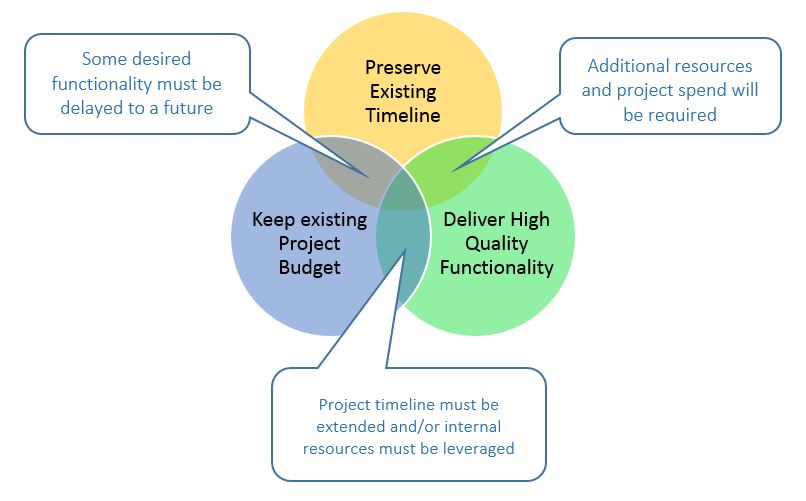Must-Read Tips for a Successful Cloud ERP Implementation

Part 2: The Top Three Implementation Considerations
Cloud ERP implementation is one of the most challenging projects an organization can face. Your new ERP will impact nearly every aspect of your business and involves a heavy investment of human and capital resources. In many cases, these projects also receive an extra level of attention from the executive team. However, with the right planning, you can effectively drive your ERP project toward success.
In Part 1 of our Cloud ERP Implementation series, we discussed the top three pre-implementation engagement considerations that must be evaluated prior to any new engagement. Decisions made prior to a project kicking off can be just as important as the decisions that are made throughout the course of the project, as those choices set the foundation for the rest of the engagement.
Let’s take a look at the three key steps your business can take to help ensure a successful ERP implementation.
DEFINE ALL KEY BUSINESS REQUIREMENTS
The requirement gathering process is the first stage of the project and the most important activity of your ERP implementation. This process sets the foundation from which all application design and configuration strategies are derived, and will impact your project scope, timelines, plan and resource needs. While it can seem expensive and time-intensive, failures here can have major timeline and financial implications. Therefore, the time you invest during this phase is sure to pay dividends during the later stages of your implementation.
Here are few tips to ensure success during your requirements gathering process:
Identify your specific business needs
- Begin by conducting a deep dive into your business needs, rules and logic that must be configured in your new software application to ensure your future-state platform supports the business.
- Next, establish a comprehensive and consistent understanding of how the application should handle standard business process flows and unique use cases.
Don’t cut corners
- Avoid the temptation of cutting corners during this important process. Any perceived cost savings achieved by short-cutting the business requirements phase is certain to be eclipsed by the cost of rework and reconfiguration in later phases.
Define your “real” requirements
- Use a system-agnostic approach, driven by your core operational needs when defining your requirements. Make sure your requirements drive the solution, not the other way around.
- Identify and involve a representative set of all internal and external stakeholders. Conduct interviews, white board sessions and use questionnaires to solicit input from the team.
Document your requirements
-
- Create a business requirement document to clearly define a comprehensive list of real business needs. This document will help drive the initial implementation and can be leveraged down the road when or if additional application changes are needed, different resources are engaged, or there is company turnover.
CAREFULLY MANAGE CHANGES IN PROJECT SCOPE
During the course of your implementation, the project scope may need to be adjusted. This can occur due to unidentified business requirements during the sales process, expansion of a product line, acquisition of a new business or many other reasons. Thus, it is imperative to establish a well-defined strategy to manage changes in scope.
Timeline, quality and budget are the three most common factors to consider when evaluating changes in scope (known as the Project Management Triangle). While all three may be important, only two can be achieved at any one time. You must make the trade-off that works best for your project objectives and budget.

Bringing It All Together
Undergoing a Cloud ERP initiative can be challenging. By incorporating these three key steps into your ERP implementation plan and the ones we outlined in Part 1 of the series, you will have the essential tools needed for a successful implementation. In addition, an experienced ERP consultant can help spearhead a successful ERP implementation. Having someone with industry experience involved throughout the process, will help ensure that your project stays on track and that you get the most from your ERP software.
Need ERP consulting to drive a successful ERP implementation?
A Texas-based leader in delivering and integrating ERP solutions including NetSuite, Bridgepoint Consulting has a large team of consultants who are here to help you make the most of your implementation. Our implementation services combine extensive ERP implementation and integration experience with industry best practices, detailed project management and a proven methodology to launch and sustain your new system. If you have any questions or would like help extending or implementing an ERP system, please contact us.
Follow us on Twitter and LinkedIn for the latest technology insights, best practices and resources to help grow and manage your business.
Jeff leads Bridgepoint Consulting’s Cloud Solutions practice, which helps companies across industries modernize their technology and processes to compete in the digital era. Jeff has extensive experience in systems implementation, accounting, finance, strategy, operations and product management.




